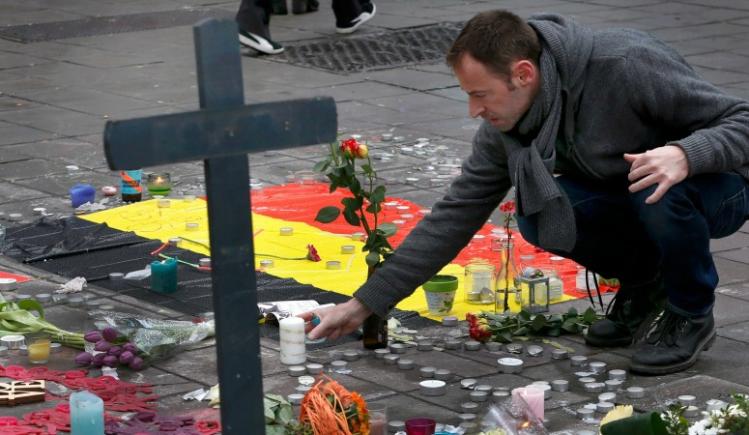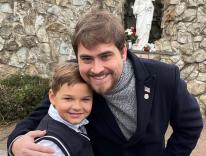
There is an uneasy feeling in Rome and all over Europe this Holy Week.
These are the most important days on the Christian calendar, centered on the Easter Triduum’s remembrance and celebration of the death and resurrection of Jesus Christ. But they are being marred and overshadowed by the latest act of terror carried out by Islamic jihadists.
After a long trail of blood stretching from Madrid (2004) to London (2005) and then multiple times in Paris (2015), the fanatics have now struck again, this time in Brussels, the symbolic heart and center of the European Union.
There is a palpable sense of nervousness here in the Eternal City that it’s probably only a matter of time before the barbarians responsible for these attacks also target Rome, once considered the prime symbol of European civilization and its Christian soul.
The unease was reflected by the abnormally low turnout in St. Peter’s Square on Wednesday for Pope Francis’s general audience. And there will probably be far fewer people than usual at the other ceremonies he leads over the next days, especially at the Stations of the Cross on Good Friday at the Colosseum, the icon par excellence of ancient Rome and its once vast empire.
We are not used to this. Rome and the Vatican are always inundated by a massive wave of tourists and religious pilgrims during Holy Week. But not this year. Crowds are visibly smaller.
And security has been beefed up yet again around the main tourist attractions, basilicas, government buildings, and embassies that are spread throughout the Urb. Army soldiers in combat gear have already become a normal fixture in all of the city’s metro stations. Even some of the areas around St. Peter’s and the Vatican look like military outposts.
The pope forcefully condemned Tuesday’s attacks in Brussels during the general audience and renewed his appeal “to all people of good will to join together in unanimous condemnation of these savage abominations that are only causing death, terror and horror.”
The secretary general of the Islamic center and great mosque of Rome was among the first to denounce the attacks as “unacceptable to Islam and Muslims.” He said that such acts of terrorism were “an affront to all religions.”
Pope Francis encouraged people to “persevere in prayer.” He urged them to ask God during these days of Holy Week to “comfort the hearts of the afflicted” and “through the intercession of the Virgin Mary,” to “convert the hearts of those blinded by savage fundamentalism.”
Everyone knows the Internet has long been buzzing with ominous predictions that the Vatican is one of the prized targets of the jihadists. But the head of the Italian parliament’s intelligence oversight committee, Giacomo Stucchi, tried to allay any such fears of this.
“Up to now [the terrorists] have never struck places in the West that are specifically symbolic of Catholicism,” he said.
****
Pope Francis has turned the notion of what constitutes a Catholic symbol entirely on its head. And he’s done so by focusing on feet—or, rather, the foot-washing ceremony at the Holy Thursday Mass of the Lord’s Supper.
As he’s routinely done in the past, both as Bishop of Rome these past three years and as Archbishop of Buenos Aires before that, he’ll again be celebrating this first liturgy of the Triduum in a community of people who are generally marginalized from the rest of society.
This year he’s heading to a refugee center for asylum seekers in Castelnuovo di Porto, some 22 miles north of the Vatican, where he’ll wash the feet of twelve young people. And, no doubt, they will include women and even Muslims, since most of the people at the center are not Christians.
The pope officially changed the Roman church’s rubrics to allow representatives of all the “People of God,” and not just men, to partake in the foot-washing ceremony. Not all the critics are happy that he’s included women in this non-sacramental ritual. But they are utterly horrified that he often washes even the feet of non-Christians, which they contend is a violation of his own rubrics.
Obviously, Francis has a more prodigal (read: lavish, generous, unsparing) interpretation of who make up God’s people. Washing the feet of women or non-members of the Church, however, is not the problem with this Pope of the Poor’s unique Holy Thursday custom.
But there is a problem. And it’s one that was all too much a part of previous pontificates, too.
Bishops should be celebrating the Sacred Triduum in their cathedrals, the mother church of their diocese. For the Bishop of Rome that would be the Cathedral Basilica of the Holy Savior, better known as St. John Lateran (in memory of John the Evangelist and John the Baptist).
Benedict XVI and John Paul II (except in the last couple years of his pontificate) always celebrated the Holy Thursday Mass at the Lateran—but none of the other liturgies of the Triduum, nor the Chrism Mass, which is specifically for consecrating holy oils used throughout the diocese.
Pope Francis should celebrate all the liturgies of the Triduum to his cathedral, especially since he has insisted—even more than his recent predecessors—that his most important title and primary role is Bishop of Rome.
If he wanted to have a Mass with the marginalized at a prison, drug rehabilitation community or refugee center he could do so at the beginning of Holy Week. And afterwards he could stay for a meal where he would serve the people and then eat with them. That, too, would be a powerful symbol of serving the lowly and poor. And it would be a more fitting occasion to demonstrate it.
It is certainly more sensible and socially relevant than using the liturgy to make a point, which is exactly what Francis seems to be doing by choosing a different “marginalized” group each year for the foot-washing ceremony. But, of course, he’s not a trained liturgist….
****
The new Annuario Pontificio—that’s the short, red, block-like directory of the Vatican, the Catholic hierarchy, and pretty much the entire worldwide Church—has been available in Rome’s ecclesiastical bookshops for a few weeks now.
And like those in past years the 2016 edition is full of interesting information that’s essential for truly understanding “who’s who” and “what’s what” in our “our Holy Mother the hierarchical Church” (as St. Ignatius of Loyola and his disciple Pope Francis like to call it).
The annuario, which has a list price of seventy-eight euros ($ 87.50), is a treasure trove of facts and figures—a real goldmine once you learn how to find what you’re looking for.
Here’s just one revealing fact that is more than just a tidbit: Cardinals Marc Ouellet (prefect of the Congregation for Bishops) and Leonardo Sandri (prefect of the Congregation for Eastern Churches) are members of eleven different Roman Curia offices. These include nine congregations, three tribunals, twelve pontifical councils, and some special commissions.
The eleven memberships that Ouellet and Sandri hold are two more than the next runner-up—Cardinal George Pell (prefect of the Secretariat for the Economy), who is a member of nine of these major offices.
Being a member—especially of a congregation or tribunal—gives a cardinal or bishop a unique opportunity to weigh-in on major decisions taken at the Vatican. Most of those who live in Rome are members of four or five such dicasteries (not nine or eleven!), while the diocesan ordinaries around the world often belong to only a couple.
Cardinal Ouellet is a member of six congregations, that’s one more than the runner-up in this sub-category—Cardinal Kurt Koch, president of the Pontifical Council for Promoting Christian Unity. No one else sits on more than four congregations as a voting member.
Rounding out the list of the top Rome-based “oligarchs”—based on the number of curia offices of which they are members— is Cardinal Jean-Louis Tauran (in charge of interreligious dialogue) with eight and Cardinals Gerhard Müller (the doctrinal chief), Kurt Koch (the top ecumenical officer), Fernando Filoni (prefect of Propaganda Fide). and Peter Turkson (head of Justice and Peace) each with seven.
Cardinal Angelo Scola of Milan leads the residential bishops with membership at eight offices—four congregations and four pontifical councils. Cardinals Luis Antonio Tagle (Manila), Péter Erdő (Esztergom-Budapest), and Agostino Vallini (Vicar of Rome) are next with seven, but only Vallini is a member of as many congregations as Scola.
Cardinal Donald Wuerl (Washington) is the leading US prelate, a member of six offices. Three of those are congregations, which is the same for New York’s Cardinal Timothy Dolan, who also belongs to two pontifical councils.
If one judges clout and influence by the number of congregations a bishop belongs to, then Cardinal Bernard Law must be considered to have been one of the most powerful men in the Vatican in recent history.
The former Archbishop of Boston was a member of seven congregations from shortly after he moved to Rome and became Archpriest of St. Mary Major in May 2004 right up to the day he turned eighty in November 2011. The only two congregations where he did not have a seat at the table were the Holy Office and the “saint-making factory”.
Please email comments to [email protected] and join the conversation on our Facebook page.
